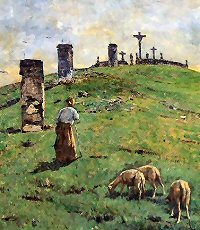Ordinary Time: October 31st

Daily Readings for: October 31, 2012
(Readings on USCCB website)
Collect: Almighty ever-living God, increase our faith, hope and charity, and make us love what you command, so that we may merit what you promise. Through our Lord Jesus Christ, your Son, who lives and reigns with you in the unity of the Holy Spirit, one God, for ever and ever.
- Barinbreac
- Barm Brack
- Boxty Bread
- Boxty Dumplings
- Boxty Pancakes
- Colcannon
- Colcannon
- Colcannon
- Doughnuts
- Dry Bones Cookies
- Eggs in Purgatory
- English Soul Cakes
- Fastnacht Doughnuts
- Fave dei Morte — Beans of the Dead
- Fave dei Morti
- Golden Flake Buttermilk Doughnuts
- Golden Flake Buttermilk Doughnuts
- Hallowe'en Barmbrack
- Halloween Punch
- Huevos Rancheros
- Irish Potato Pancakes
- Panes de Muertos
- Potato Apple Cake
- Potato Cake
- Potato Dish
- Potato Doughnuts
- Potato Pancakes
- Potato Pancakes
- Potato Patties
- Potato Pudding
- Soul Cakes
- Soul Cakes
- Soul Cakes
- All Hallow's Eve or Halloween Activities
- All Saints' Day in Louisiana
- All Souls' Day: Soulmas
- Bobbing for Apples
- Feast of All Saints Ideas for the Home
- Feasts of All Saints and All Souls
- Halloween or All Hallow's Eve Activities
- Halloween Party
- Halloween Traditions in a Catholic Light
- Halloween, All Saints, and All Souls
- October 31 — Halloween
- Praying for the Dead and Gaining Indulgences During November
- Preparing for Heaven
- Procession for the Feast of All Saints
- Religion in the Home for Preschool: October
- Snap Apples
RECIPES
ACTIVITIES
PRAYERS
LIBRARY
Wednesday of the Thirty-First Week of Ordinary Time; All Hallows' Eve
Today we celebrate the eve of All Saints. Pope Sixtus IV in 1484 established November 1, the feast of All Saints, as a holy day of obligation and gave it both a vigil (known today as "All Hallows' Eve" or "Hallowe'en") and an eight-day period or octave to celebrate the feast. By 1955, the octave of All Saints was removed.
All Hallows' Eve
Halloween or All Hallows' Eve is not a liturgical feast on the Catholic calendar, but the celebration has deep ties to the Liturgical Year. These three consecutive days — Halloween, All Saints Day and All Souls Day — illustrate the Communion of Saints. The Church Militant (those on earth, striving to get to heaven) pray for the Church Suffering (those souls in Purgatory) especially on All Souls Day and the month of November. We also rejoice and honor the Church Triumphant (the saints, canonized and uncanonized) in heaven. We also ask the Saints to intercede for us, and for the souls in Purgatory.
or All Hallows' Eve is not a liturgical feast on the Catholic calendar, but the celebration has deep ties to the Liturgical Year. These three consecutive days — Halloween, All Saints Day and All Souls Day — illustrate the Communion of Saints. The Church Militant (those on earth, striving to get to heaven) pray for the Church Suffering (those souls in Purgatory) especially on All Souls Day and the month of November. We also rejoice and honor the Church Triumphant (the saints, canonized and uncanonized) in heaven. We also ask the Saints to intercede for us, and for the souls in Purgatory.
Since Vatican II, some liturgical observances have been altered, one example being "fast before the feast" is no longer required. Originally, the days preceding great solemnities, like Christmas and All Saints Day, had a penitential nature, requiring abstinence from meat and fasting and prayer. Although not required by the Church, it is a good practice to prepare spiritually before great feast days.
In England, saints or holy people are called "hallowed," hence the name "All Hallow's Day." The evening, or "e'en" before the feast became popularly known as "All Hallows' Eve" or even shorter, "Hallowe'en."
Since the night before All Saints Day, "All Hallows Eve" (now known as Hallowe'en), was the vigil and required fasting, many recipes and traditions have come down for this evening, such as pancakes, boxty bread and boxty pancakes, barmbrack (Irish fruit bread with hidden charms), colcannon (combination of cabbage and boiled potatoes). This was also known as "Nutcrack Night" in England, where the family gathered around the hearth to enjoy cider and nuts and apples.
Halloween is the preparation and combination of the two upcoming feasts. Although the demonic and witchcraft have no place for a Catholic celebration, some macabre can be incorporated into Halloween. It is good to dwell on our impending death (yes, everyone dies at one point), the Poor Souls in Purgatory, and the Sacrament of the Sick. And tied in with this theme is the saints, canonized and non-canonized. What did they do in their lives that they were able to reach heaven? How can we imitate them? How can we, like these saints, prepare our souls for death at any moment?
For more information see Catholic Culture's Halloween page.
Also read from Catholic Culture's library:
- Ideas for Sanctifying Halloween, All Saints Day and All Souls Day by Jennifer Gregory Miller
- Halloween and All Saints Day by Father William Saunders
- Holyween: Reclaim The Celebration Of All Saints by Fr. Vincent Serpa, O.P.
- Catholics Give the Best Parties by Jeffrey Tucker.